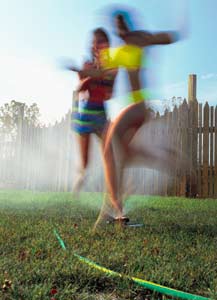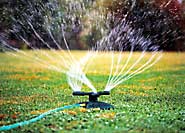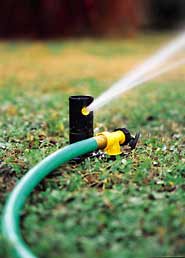
In Camelot, there's no need for a garden sprinkler--sunny days and evening rains keep things green all the time. But most of us don't live in Camelot, so we need some kind of sprinkler system to achieve and maintain a healthy garden.
The original sprinkler was a gardener's thumb pressed down on the end of a hose. The problem was standing there long enough to make a difference. Most gardeners can't. So it wasn't long before sprinkler heads that screw onto the end of a hose were invented. Not surprisingly, further ingenuity has been applied, so that now we can choose from a wide variety of designs.
If you live where watering lawns and gardens is a way of life, such as in the dry-summer Western states, or if the value of your landscape or the cost of labor is very high, an automated in-ground system makes the best sense. All you have to do is monitor it occasionally to be sure it's working correctly. But in-ground systems are initially very expensive and, once in place, are difficult to adapt to new plants or configurations.
If you're like many home gardeners, especially if you live in the rainy-summer East, the versatility and low cost of portable sprinklers make them a top choice. There's simply no more versatile or inexpensive way to water your lawn and garden.
Last year we shopped for the latest models and tested them. When you shop, you'll still find four basic designs: stationary, spinning, rotary and impulse, and oscillating. What you may not know is that new, rugged plastics and refined designs make the newest versions of these sprinklers work better and last longer than their predecessors.
Our testing demonstrated a fundamental principle of portable sprinklers: all start with the same amount of water, namely, the maximum amount your water line and hose can deliver. The sprinklers then spread that water over as little as 100 square feet, or as much as 7,850 square feet. Therefore, the smaller the area covered by the sprinkler, the faster the water is applied; the larger the area, the slower. The rate of water application is called the precipitation rate. Knowing how fast the water is applied is the only way you can know how long to let the sprinkler operate.
By testing, we also learned that water is not applied evenly over the wetted area. In some cases the inequalities were minor; in others they were significant. The only way to know is to set several containers (such as tuna fish cans) over the area you want to water. Operate the sprinkler for a half-hour or so, then measure the depth of water in the cans. This tells you not only how evenly the sprinkler applies water, but also how fast.
 Four Common Sprinklers
Four Common Sprinklers
Even though individual situations vary widely, all four basic types of sprinklers are designed to operate best at water pressure of 50 pounds per square inch and with a hose diameter of 5/8 inch. Listings also note each kind's benefits and best uses, how it performed in our tests, and our favorite models of each type.
Stationary. Nothing moves but the water. Some are ring-shaped with dozens of holes molded in the top through which water shoots; others offer various spray patterns. Their chief virtue, besides low cost, is the ability to deliver water quickly to small, distinctly shaped areas. But because of the nozzles' many small holes, they are prone to clogging.
Top choice: Melnor 4-Way Turret (model 675, $8) has four spray patterns to cover common situations: a square (maximum 30 by 30 feet), a rectangle (20 by 30 feet), a narrow strip (5 by 17 feet), and a wide strip (10 by 50 feet). Select the shape you want by rotating the correct nozzle into place. Reduce the area covered by adjusting the flow at the hose bibb. Brass nozzles promise good longevity. We found coverage to be a moderately uniform 5/8 inch per hour, differing by about 1/4 inch over the spray pattern. The performance of the Nelson Spot Rain 40 (model 2105, $4) is similar, but it offers less flexibility. Maximum coverage is a 40-foot circle (1,250 square feet).
Spinning sprinklers. Like stationary sprinklers, this type quickly delivers a lot of water to a small area. The moving water spins the nozzle, a motion that then helps to break up and distribute the spray. These sprinklers with their two or three relatively large nozzles rarely clog because most debris in water can pass right through. Costlier versions have adjustable nozzles on the sides of the arm, which provide flexibility of coverage and amount of water delivered.
Top choice: Melnor's Revolving Sprinkler (model 873, $11) features a durable heavy plastic housing and a butterflylike base that provides enough stability to stay where you want it. Maximum coverage is a 60-foot circle (2,825 square feet), minimum is 5 by 5 feet. We found above-average uniformity with differences of 1/8 inch or less. The rate of application is about 1/2 inch per hour.
Rotary and impulse. Both types water large circles or portions thereof, but in different ways. Rotary sprinklers use an ingenious water-powered gear system to silently move the spray stream back and forth. Impulse sprinklers advance using the inertia of a spring-activated counterweight bouncing off the water stream. The counterweight striking the stream of impulse types makes the thwack-thwack that is a familiar sound of summer for many gardeners.
The pattern is always circular, and you move a set of tabs to control how many degrees of a circle are covered (usually between 15 and 360 degrees). There's also an adjustment for how far within the circle the stream shoots, from about 15 feet to more than 50 feet (7,850 square feet maximum coverage).
Generally, as the area to be watered increases, the precipitation rate goes down, and vice versa. But some rotary and impulse sprinklers have replaceable nozzles that allow you to have the same rate of application regardless of area covered.
Top choice: Melnor Rotary Lawn Sprinkler (model 2900, $17) has a broad, solid sled base that is not likely to tip. It is very quiet and has three nozzle heads for mist, medium, or large spray coverage. Minimum spray distance is 10 feet, maximum 40 feet; maximum area covered is 5,000 square feet. In our tests, this sprinkler delivered about 1/2 inch of water per hour with moderate uniformity.
Oscillating sprinklers. If we had to choose only one sprinkler type, this would be it. These sprinklers water large rectangular shapes, shooting 14 to 20 tiny streams of water high into the air and are ideal for open areas with no obstructing trees. They provide the slow, gentle soaking that slopes, heavy clay soils, and seed beds need. Their nemesis is wind: even moderate gusts blow the high, thin streams away.
Emitters on these sprinklers may simply be holes in an aluminum tube. Better models will have brass nozzles that you can remove to clean. Most models tend to pause slightly at both ends of the sweep, causing relatively more water to fall there. Better designs avoid the problem with an "instant return" feature.
Top choice: The Naan Whisper Quiet Oscillator (model 520, $30) wins for its versatility. You can set it to spray or mist, and, by choosing the number of nozzles in operation, you can adjust the spray width as easily as its length. Maximum coverage is a 50 by 70 foot rectangle (3,500 square feet), minimum is 210 square feet. In our tests, the sprinkler delivered about 1/4 inch of water per hour with high uniformity.
 Two Novel Designs
Two Novel Designs
"Walking" sprinkler. The Rain Train (model 1865, $60), made by Nelson, follows the path defined by a hose. A water pressure-driven motor slowly propels the sprinkler along up to 200 feet of hose. It is excellent for wide, open areas, and its spinning spray boom can cover up to 16,000 square feet of lawn.
Commercial-quality rotary sprinkler. The Snap-N-Rain (model 5005, $25), also by Nelson, is buried at sod level, but instead of connecting to an underground pipe, it has an aboveground hose connection. It offers many of the features of an in-ground system but at a fraction of the cost.
Ed Hutchison is a garden writer based in Midland, Michigan.
Photography by John Goodman
 Victory Seed Company has all the seeds you want for your best garden in 2024.
Victory Seed Company has all the seeds you want for your best garden in 2024.
For 25 years, the family-owned Victory Seed Company has provided the highest quality vegetable, herb and flower seeds to families across the country. We are passionate about providing you the best seeds available that give excellent germination, robust plants, and the harvest you want. With a catalog of over a thousand varieties, we have everything, and our prices are the kinds that we'd want to pay. We have hundreds of yesterday's heirloom vegetables, as well as today's award winning hybrid selections. Get to know us by visiting our website and browsing through our online vegetable seed catalog.